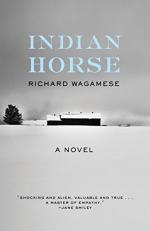|
This section contains 556 words (approx. 2 pages at 400 words per page) |

|
Indian Horse Summary & Study Guide Description
Indian Horse Summary & Study Guide includes comprehensive information and analysis to help you understand the book. This study guide contains the following sections:
This detailed literature summary also contains Quotes and a Free Quiz on Indian Horse by Richard Wagamese.
The following version of this book was used to create this study guide: Wagamese, Richard. Indian Horse. Milkweed Editions, 2018.
The story follows Saul Indian Horse a native Canadian of the Ojibway tribe. He is born in the early 1950s. When he is young, his brother and sister are both kidnapped by white Canadians. Saul, his parents, and his grandmother then live a semi-nomadic life to evade further harm from white Canadians. There is tension between the mother and the grandmother; the mother was converted to Christianity at a young age and does not respect Ojibway traditions. Saul’s parents disappear one day while on a hunting trip. Saul’s grandmother dies of cold, and Saul is found by white Canadians.
Saul is brought to a Christian missionary school. The other students are all native Canadians who were all taken from their families. The faculty consists of priests and nuns who are highly abusive towards the children. Many of the children die of suicide and disease, and they are employed in forced labor rather than actually being educated. Saul is introduced to the sport of hockey while at the school. He loves the sport and has much natural talent for it. He befriends the coach of the school’s team, Father Leboutilier. Saul leaves the school when he is 12 years old, as a man named Fred Kelly offers to be his legal guardian. Fred Kelly is also an indigenous Canadian and was a student at the same missionary school as Saul. Fred lives on a native reservation in Manitouwadge and coaches the local youth team, the Moose.
Saul quickly becomes the star player of the Moose. At first, the Moose only play other teams of native Canadians. They win many games thanks to Saul, and their reputation grows. A white team challenges them to a match, and the Moose manage to win because of Saul. Many other white teams challenge the Moose to matches. The white players and spectators all demonstrate deep hatred for the natives. One time, some white men even physically attack them after the Moose win a match. A few years after Saul’s arrival to Manitouwadge, a scout visits him and recruits him for a minor league hockey team, the Toronto Marlboros. Saul eventually accepts the offer and moves to Toronto. However, he faces such severe persecution there due to his race that he eventually returns to Manitouwadge.
Saul works for a temporary period as a logger. The white loggers working in the same logging camp heavily persecute Saul, and he eventual fights back. When he quits the job as a logger, he is 17 years old and has become quite angry and bitter. He then leas a transient lifestyle, performing manual labor in various parts of the province. He becomes an alcoholic. One day, he visits St. Jerome’s and finds that it has been closed for a decade. He suddenly remembers that he was sexually abused by Father Leboutilier and had repressed the memories. Saul eventually checks in to a rehabilitation clinic and begins his journey to sobriety. With the help of Fred Kelly, he initiates his journey to emotional recovery from his past traumas. Years later, Saul has recovered substantially and is able to enjoy hockey again. He decides to become the coach for the Manitouwadge Moose.
Read more from the Study Guide
|
This section contains 556 words (approx. 2 pages at 400 words per page) |

|



